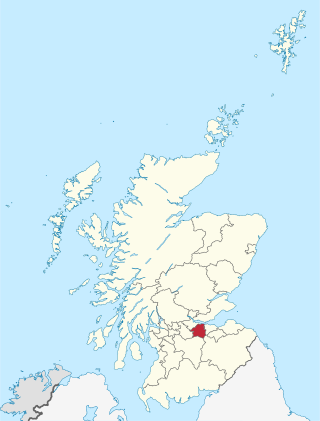
West Lothian is one of the 32 council areas of Scotland, and was one of its historic counties. The county was called Linlithgowshire until 1925. The historic county was bounded geographically by the Avon to the west and the Almond to the east. The modern council area occupies a larger area than the historic county. It was reshaped following local government reforms in 1975: some areas in the west were transferred to Falkirk; some areas in the east were transferred to Edinburgh; and some areas that had formerly been part of Midlothian were added to West Lothian.
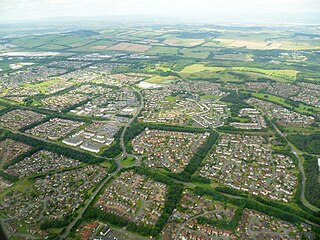
Livingston is the largest town in West Lothian, Scotland. Designated in 1962, it is the fourth post-war new town to be built in Scotland. Taking its name from a village of the same name incorporated into the new town, it was originally developed in the then-counties of Midlothian and West Lothian along the banks of the River Almond. It is situated approximately fifteen miles (25 km) west of Edinburgh and thirty miles (50 km) east of Glasgow, and is close to the towns of Broxburn to the north-east and Bathgate to the north-west.

Broxburn is a town in West Lothian, Scotland. It is 12 miles (19 km) from the West End of Edinburgh, 5 miles (8.0 km) from Edinburgh Airport and 5 miles (8.0 km) to the north of Livingston. Originally a village known as Easter Strathbock in the medieval period, by 1600, the village had become known as Broxburn. The area developed rapidly during the Victorian era as a result of industralisation related to shale oil extraction. While much of the industry in the area is now diminished, the town has continued to grow following new residential development, resulting in Broxburn forming a conurbation with neighbouring Uphall. It lies just to the south of Winchburgh.

Bathgate is a town in West Lothian, Scotland, 5 miles (8 km) west of Livingston and adjacent to the M8 motorway. Nearby towns are Armadale, Blackburn, Linlithgow, Livingston, West Calder and Whitburn. Situated 2 miles (3 km) south of the ancient Neolithic burial site at Cairnpapple Hill, Bathgate and the surrounding area show signs of habitation since about 3500 BC and the world's oldest known reptile fossil has been found in the town. By the 12th century, Bathgate was a small settlement, with a church at Kirkton and a castle south of the present day town centre. Local mines were established in the 17th century but the town remained small in size until the coming of the industrial revolution. By the Victorian era, Bathgate grew in prominence as an industrial and mining centre, principally associated with the coal and shale oil industries. By the early 20th century, much of the mining and heavy industry around the town had ceased and the town developed manufacturing industries, principally in vehicle production and later electronics before these factories closed in the late 20th century. Today Bathgate is the second largest town in West Lothian, after Livingston and serves as a regional commuter town within the Scottish Central Belt.
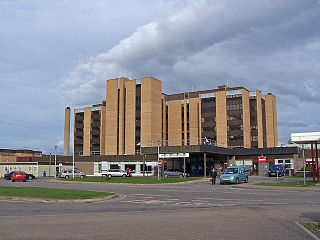
Raigmore Hospital is a health facility located in Inverness, Scotland. It serves patients from the local area as well as providing specialist services to patients from across the Highland area. It is a teaching hospital, educating a range of healthcare professionals in association with the Universities of Aberdeen and Stirling. It is managed by NHS Highland.
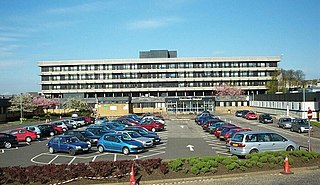
University Hospital Monklands is a district general hospital in Airdrie, North Lanarkshire, Scotland. It serves a population of approximately 260,000 people of North and South Lanarkshire council areas and is managed by NHS Lanarkshire.
The Edinburgh–Bathgate line is a railway line in East Central Scotland. It is also known as the Bathgate branch and was originally operated by the Edinburgh and Bathgate Railway. Except for the short section at the original Bathgate terminus, the main line is still in use, with a frequent passenger train service operated by ScotRail.

The Royal Infirmary of Edinburgh (RIE), often known as the Edinburgh Royal Infirmary (ERI), was established in 1729 and is the oldest voluntary hospital in Scotland. The new buildings of 1879 were claimed to be the largest voluntary hospital in the United Kingdom, and later on, the Empire. The hospital moved to a new 900 bed site in 2003 in Little France. It is the site of clinical medicine teaching as well as a teaching hospital for the University of Edinburgh Medical School. In 1960, the first successful kidney transplant performed in the UK was at this hospital. In 1964, the world's first coronary care unit was established at the hospital. It is the only site for liver, pancreas and pancreatic islet cell transplantation and one of two sites for kidney transplantation in Scotland. In 2012, the Emergency Department had 113,000 patient attendances, the highest number in Scotland. It is managed by NHS Lothian.

West Lothian Council is the local authority for the council area of West Lothian in Scotland.

Bangour Village Hospital was a psychiatric hospital located west of Dechmont in West Lothian, Scotland. During the First World War it formed part of the much larger Edinburgh War Hospital.

NHS Lothian is one of the 14 regions of NHS Scotland. It provides healthcare services in the City of Edinburgh, East Lothian, Midlothian and West Lothian council areas. Its headquarters are at Waverley Gate, Edinburgh

Healthcare in the United Kingdom is a devolved matter, with England, Northern Ireland, Scotland and Wales each having their own systems of publicly funded healthcare, funded by and accountable to separate governments and parliaments, together with smaller private sector and voluntary provision. As a result of each country having different policies and priorities, a variety of differences have developed between these systems since devolution.
Bangour General Hospital was a hospital just west of the village of Dechmont, West Lothian, Scotland. It had its origins during the Second World War when hospital bed numbers in Scotland were greatly expanded to deal with the anticipated increase in civilian and military war casualties. The Emergency Hospital Service (Scotland) scheme resulted in seven new hospitals being built, while at Bangour Village Hospital in West Lothian an annexe of five ward blocks was built and this developed into Bangour General Hospital after the war. This hospital served the population of West Lothian as a general hospital and also included a maxillo-facial unit serving the Lothian region and a burns and plastic surgery unit serving much of east Scotland, the Borders and the Highland region. The hospital services were transferred to the newly built St John's Hospital at Livingston during 1989–90, and Bangour General Hospital closed in 1990 and was subsequently demolished.
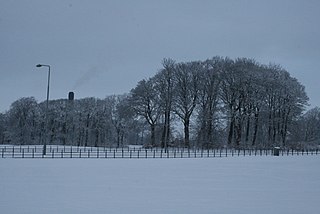
Howden is an area of the new town of Livingston, the largest town in West Lothian, Scotland. Howden is bordered by Craigshill, Ladywell, Almondvale and Kirkton.

Alexander Burns Wallace (1906–1974) was a Scottish plastic surgeon. He was a founding member and president (1951) of the British Association of Plastic Surgeons, and the first editor of the British Journal of Plastic Surgery. In authorship he appears as A. B. Wallace.
Radio Grapevine is the hospital radio station serving St John's Hospital in Livingston, Scotland.

Vanguard Healthcare Solutions Ltd. is a provider of mobile and modular healthcare solutions based in Gloucester.

The Edinburgh City Hospital was a hospital in Colinton, Edinburgh, opened in 1903 for the treatment of infectious diseases. As the pattern of infectious disease changed, the need for in-patients facilities to treat them diminished. While still remaining the regional centre for infectious disease, in the latter half of the 20th century the hospital facilities diversified with specialist units established for respiratory disease, ear, nose and throat surgery, maxillo-facial surgery, care of the elderly and latterly HIV/AIDS. The hospital closed in 1999 and was redeveloped as residential housing, known as Greenbank Village.
















